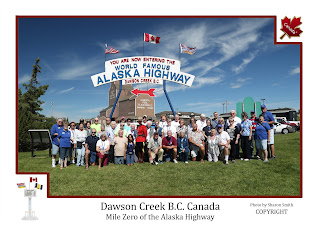Alaska is the only of the 50
states that I have not visited for at least a full day in my lifetime. I remember Alaska and the Alcan being
excitedly talked about by the folks in Mom's generation at family gatherings
after WW-II. I believe that my uncle
Lester rode at least a part of the Alcan on his motorcycle - from Newton, KS to
the start of the highway is over 2000 mi. one-way - on very 'unimproved' roads
according to today's standards. And, my
Dad had some connection to the highway in his days in the Navy, possibly
leading him to chose to spend the later years of his life in Alaska.
The Alcan was first completed
in 1942, in under 12-months, 2/11 to 11/20/42,
It extended some 1420 miles from Dawson Creek, BC to Delta Junction, AK
- just short of Fairbanks. It was built by
some 11,000 US Army troops, supplemented with 16,000 US and Canadian civilians. An ad by Bechtel-Price- Callahan to recruit civilian
workers read …"Men hired for this job will
be required to work and live under the most extreme conditions imaginable. Temperatures will range from 90 degrees above
to 70 degrees below zero. Mel will have
to fight swamps, rivers, ice and cold.
Mosquitoes, flies, and gnats will not only be annoying, but will cause
bodily harm. If you are not prepared to
work under these and similar conditions, do not apply".
The $140M project was funded by
US Congress in an effort to circumvent a threatened occupation of Alaska and
the Aleutians by Axis invaders. They built this dirt road simultaneously in
about a dozen sections with over 180 bridges.
Completion of this road in that amount of time, under the hazards of
this environment is truly one of the most outstanding engineering
accomplishments in history!
Unfortunately, this development
also wrote another chapter in the book of "the ugly American". Recreational hunting and pillaging of native
animals (caribou, moose, bears…) by the road-builders seriously depleted the
population and upset life patterns of these creatures. The indigenous people of
Alaska and Canada had responded positively and successfully to an earlier
invasion of trappers and hunters by virtue of their superior skills. This onslaught not only displaced these
native people, but their populations were significantly reduced by plagues of
measles, mumps, scarlet fever and other diseases of the 'civilized world'.
The road is now called the "Alaska
Highway", and runs on to/past Fairbanks. Among other improvements, over 97% of the
road is now paved (although our journey will include many extra miles of
unpaved roads). The Alaska Pipeline
generally follows the route of Highway in northern Alaska. Civilization is rampant along the Alaska Highway ...And here comes the next set of invaders.
You are Here: Tour Miles 518-852



No comments:
Post a Comment